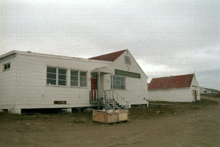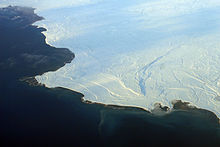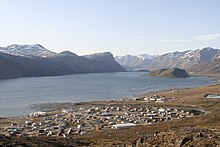VY0BRR-Iqaluit, Nunavut
History
Iqaluit has been a traditional fishing location used by Inuit for thousands of years, hence the name Iqaluit, which means place of many fish. In 1942 an American air base was built there, intended to provide a stop-over and refuelling site for short range aircraft being ferried to Europe to support the war effort. Iqaluit's first permanent resident was Nakasuk, an Inuk guide who helped American Air Force planners to choose a site with a large flat area suitable for a landing strip. The wartime airstrip was known as Crystal Two and was part of the Crimson Route. Long regarded as a campsite and fishing spot by the Inuit, the place chosen had been called Iqaluit – "place of many fish" in Inuktitut – but Canadian and American authorities named it Frobisher Bay, after the name of the body of water it abuts. For the history of the air base, see Frobisher Bay Air Base.

The Hudson's Bay Company moved its south Baffin operations to the neighbouring valley of Niaqunngut, officially called Apex, in 1949 to take advantage of the airfield. The population of Frobisher Bay increased rapidly during the construction of the Distant Early Warning Line(DEW line, a system of radar stations, see North American Aerospace Defense Command(NORAD)) in the mid-1950s. Hundreds of construction workers, military personnel, and administrative staff moved into the community, and several hundred Inuit followed to take advantage of the access to medical care and jobs the base provided. In 1957, 489 of the town's 1,200 residents were reported to be Inuit. After 1959, the Canadian government established permanent services at Frobisher Bay, including full-time doctors, a school and social services. The Inuit population grew rapidly in response, as the government encouraged Inuit to settle permanently in communities with government services.
Naval Radio Station (NRS) Frobisher Bay, callsign CFI, was established in July 1954 as a result of the closure of NRS Chimo, Quebec. Station CFI was part of the Supplementary Radio network. Because of its remoteness and size, it was very expensive to operate. Advancing technology eventually forced the closure of CFI in 1967.
The American military left Iqaluit in 1963, as intercontinental ballistic missiles (ICBM) diminished the strategic value of the DEW line and Arctic airbases, but Frobisher Bay remained the government's administrative and logistical centre for much of the eastern Arctic. In 1964, the first elections were held for a community council, and in 1979 for the first mayor. The founding of the Gordon Robertson Educational Centre, now Inuksuk High School, in the early 1970s at Iqaluit confirmed the government's commitment to the community as an administrative centre. At the time of its founding, it was the sole high school operating in more than one-seventh of Canadian territory.
On 1 January 1987, the name of the municipality was changed from "Frobisher Bay" to "Iqaluit" – aligning official usage with the name that the Inuit population had always used (although, many documents still referred to Iqaluit as Frobisher Bay for several years after 1987). In December 1995, Iqaluit was selected to serve as Nunavut's future capital in a territory-wide referendum, in which it was chosen over Rankin Inlet. On 19 April 2001, it was redesignated as a city.
Iqaluit was designated by Canada as the host city for the 2010 meeting of the G7 finance ministers, held on 5–6 February.The meeting strained the northern communications technology infrastructure.(Souce Wikipedia.)
The region now known as Nunavut has supported a continuous indigenous population for approximately 4,000 years. Most historians identify the coast of Baffin Island with the Helluland described in Norse sagas, so it is possible that the inhabitants of the region had occasional contact with Norse sailors.
Archaeological findings
In September 2008, researchers reported on the evaluation of existing and newly excavated archaeological remains, including yarn spun from a hare, rats, tally sticks, a carved wooden face mask that depicts Caucasian features, and possible architectural material. The materials were collected in five seasons of excavation at Cape Tanfield. Scholars determined that these provide evidence of European traders and possibly settlers on Baffin Island, not later than 1000 CE (and thus older than or contemporaneous with L'Anse aux Meadows). They seem to indicate prolonged contact, possibly up to 1450. The origin of the Old World contact is unclear; the article states: "Dating of some yarn and other artifacts, presumed to be left by Vikings on Baffin Island, have produced an age that predates the Vikings by several hundred years. So […] you have to consider the possibility that as remote as it may seem, these finds may represent evidence of contact with Europeans prior to the Vikings' arrival in Greenland.

First written historical accounts
The written historical accounts of Nunavut begin in 1576, with an account by English explorer Martin Frobisher. While leading an expedition to find the Northwest Passage, Frobisher thought he had discovered gold ore around the body of water now known as Frobisher Bay on the coast of Baffin Island.[20] The ore turned out to be worthless, but Frobisher made the first recorded European contact with the Inuit. Other explorers in search of the elusive Northwest Passage followed in the 17th century, including Henry Hudson, William Baffin and Robert Bylot.
Cold War
Cornwallis and Ellesmere Islands featured in the history of the Cold War in the 1950s. Concerned about the area's strategic geopolitical position, the federal government relocated Inuit from Nunavik (northern Quebec) to Resolute and Grise Fiord. In the unfamiliar and hostile conditions, they faced starvation[21] but were forced to stay.Forty years later, the Royal Commission on Aboriginal Peoples issued a report titled The High Arctic Relocation: A Report on the 1953–55 Relocation. The government paid compensation to those affected and their descendents and on August 18, 2010 in Inukjuak, Nunavik, the Honourable John Duncan, PC, MP, previous Minister of Indian Affairs and Northern Development and Federal Interlocutor for Métis and Non-Status Indians apologized on behalf of the Government of Canada for the relocation of Inuit to the High Arctic.[
Recent history
Discussions on dividing the Northwest Territories along ethnic lines began in the 1950s, and legislation to do this was introduced in 1963. After its failure a federal commission recommended against such a measure. In 1976, as part of the land claims negotiations between the Inuit Tapiriit Kanatami (then called the "Inuit Tapirisat of Canada") and the federal government, the parties discussed division of the Northwest Territories to provide a separate territory for the Inuit. On April 14, 1982, a plebiscite on division was held throughout the Northwest Territories. A majority of the residents voted in favour and the federal government gave a conditional agreement seven months later.
The land claims agreement was completed in September 1992 and ratified by nearly 85% of the voters in Nunavut in a referendum. On July 9, 1993, the Nunavut Land Claims Agreement Act and the Nunavut Act were passed by the Canadian Parliament. The transition to establish Nunavut Territory was completed on April 1, 1999.The creation of Nunavut has been followed by growth in the capital, Iqaluit—a modest increase from 5,200 in 2001 to 6,600 in 2011.
The population growth rate of Nunavut has been well above the Canadian average for several decades, mostly due to birth rates significantly higher than the Canadian average—a trend that continues. Between 2011 and 2016, Nunavut had the highest population growth rate of any Canadian province or territory, at a rate of 12.7%.The second-highest was Alberta, with a growth rate of 11.6%.
Language
Along with the Inuit Language (Inuktitut and Inuinnaqtun) sometimes called Inuktut, English and French are also official languages.
In his 2000 commissioned report (Aajiiqatigiingniq Language of Instruction Research Paper) to the Nunavut Department of Education, Ian Martin of York University stated a "long-term threat to Inuit languages from English is found everywhere, and current school language policies and practices on language are contributing to that threat" if Nunavut schools follow the Northwest Territories model. He provided a 20-year language plan to create a "fully functional bilingual society, in Inuktitut and English" by 2020. The plan provides different models, including:
- "Qulliq Model", for most Nunavut communities, with Inuktitut as the main language of instruction.
- "Inuinnaqtun Immersion Model", for language reclamation and immersion to revitalize Inuinnaqtun as a living language.
- "Mixed Population Model", mainly for Iqaluit (possibly for Rankin Inlet), as the 40% Qallunaat, or non-Inuit, population may have different requirements.
Of the 29,025 responses to the census question concerning 'mother tongue', the most commonly reported languages were:
| Rank | Language | Number of respondents | Percentage |
|---|---|---|---|
| 1 | Inuktitut | 20,185 | 69.54% |
| 2 | English | 7,765 | 26.75% |
| 3 | French | 370 | 1.27% |
| 4 | Inuinnaqtun | 295 | 1.02% |
At the time of the census, only English and French were counted as official languages. Figures shown are for single-language responses and the percentage of total single-language responses.
In the 2006 census it was reported that 2,305 people (7.86%) living in Nunavut had no knowledge of either official language of Canada (English or French).
Religion
The largest denominations by number of adherents according to the 2001 census were the Anglican Church of Canada with 15,440 (58%); the Roman Catholic Church (Roman Catholic Diocese of Churchill-Hudson Bay) with 6,205 (23%); and Pentecostal with 1,175 (4%). In total, 93.2% of the population were Christian.
The economy of Nunavut is Inuit and Territorial Government, mining, oil gas mineral exploration, arts crafts, hunting, fishing, whaling, tourism, transportation, education - Nunavut Arctic College, housing, military and research – new Canadian High Arctic Research Station CHARS in planning for Cambridge Bay and high north Alert Bay Station. Iqaluit hosts the annual Nunavut Mining Symposium every April, this is a tradeshow that showcases many economic activities on going in Nunavut.
Mining and exploration
There are currently three major mines in operation in Nunavut.
Agnico-Eagle Mines Ltd – Meadowbank Division. Meadowbank is an open pit gold mine with an estimated mine life 2010–2020 and employs 680 persons. The second recently opened mine in production is the Mary River Iron Ore mine operated by Baffinland Iron Mines. It is located close to Pond Inlet on North Baffin Island. They produce a high grade direct ship iron ore.
The most recent mine to open is Doris North or the Hope Bay Mine operated by TMAC Resource Ltd. This new high grade gold mine is the first in a series of potential mines in gold occurrences all along the Hope Bay greenstone belt.
Advancing mining projects[edit]
| Name | Company | In the region of | Material |
|---|---|---|---|
| Amaruq and Meliadine Gold Projects | Agnico-Eagle | Rankin Inlet | Gold |
| Back River Project | Sabina Gold & Silver Corp. | Bathurst Inlet | Gold |
| Izok Corridor Project | MMG Resources Inc. | Kugluktuk | Gold, Copper, Silver, Zinc |
| Hackett River | Glencore | Kugluktuk | Copper, Lead, Silver, Zinc |
| Chidliak | Peregrine Diamonds Ltd. | Iqaluit / Pangnirtung | Diamonds |
| Committee Bay, Three Bluffs Gold Project | Auryn Resources Inc | Naujaat | Gold |
| Kiggavik | Areva Resources | Baker Lake | Uranium |
| Roche Bay | Advanced Exploration | Hall Beach | Iron Ore |
| Ulu and Lupin | Elgin Mining Ltd. | Contwoyto Lake - connected to Yellowknife with an ice road | Gold |
| Storm Copper Property | Aston Bay Holdings | Taloyoak | Copper |
Historic mine]
- Lupin Mine 1982–2005, gold, current owner Elgin Mining Ltd located near the Northwest Territories boundary near Contwoyto Lake)
- Polaris Mine 1982–2002, lead and zinc (located on Little Cornwallis Island, not far from Resolute)
- Nanisivik Mine 1976–2002, lead and zinc, prior owner Breakwater Resources Ltd (near Arctic Bay) at Nanisivik
- Rankin Nickel Mine 1957–1962, nickel, copper and platinum group metals
- Jericho Diamond Mine 2006–2008, diamond (located 400 km, 250 mi, northeast of Yellowknife) 2012 produced diamonds from existing stockpile. No new mining; closed.
- Doris North Gold Mine Newmont Mining approx 3 km (2 mi) underground drifting/mining, none milled or processed. Newmont closed the mine and sold it to TMAC Resources in 2013. TMAC has now reached commercial production in 2017.
Transportation
- Northern Transportation Company Limited, owned by Norterra, a holding company that was, until April 1, 2014, jointly owned by the Inuvialuit of the Northwest Territories and the Inuit of Nunavut.
Renewable power

Nunavut's people rely primarily on diesel fuel to run generators and heat homes, with fossil fuel shipments from southern Canada by plane or boat because there are few to no roads or rail links to the region. There is a government effort to use more renewable energy sources,which is generally supported by the community.
This support comes from Nunavut feeling the effects of global warming. Former Nunavut Premier Eva Aariak said in 2011, "Climate change is very much upon us. It is affecting our hunters, the animals, the thinning of the ice is a big concern, as well as erosion from permafrost melting.The region is warming about twice as fast as the global average, according to the UN's Intergovernmental Panel on Climate Change.

This is a school in the shape of an igloo to have lots of heat retention and natural light.

This is rush hour in busy Iqaluit.




